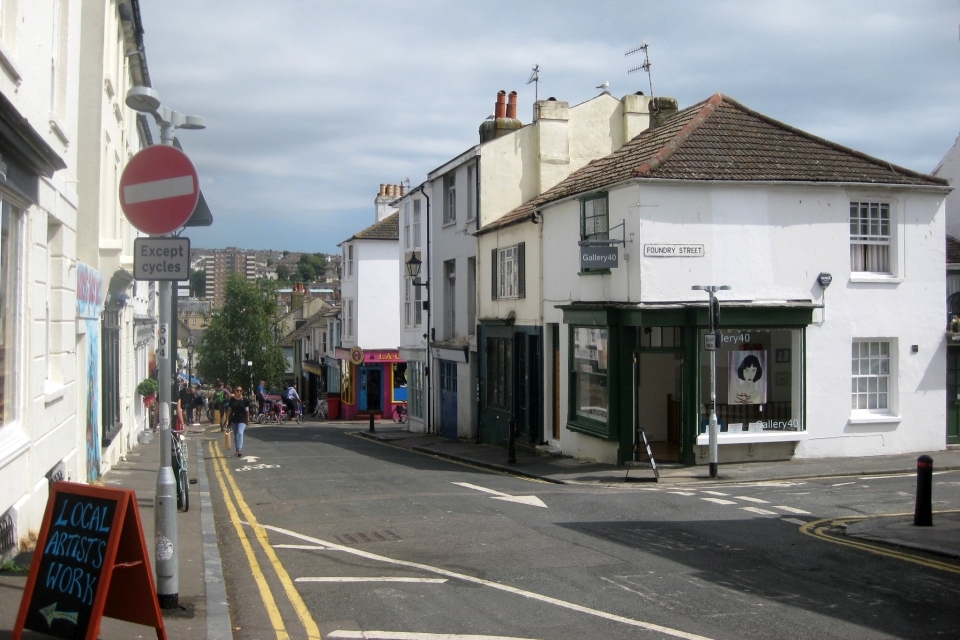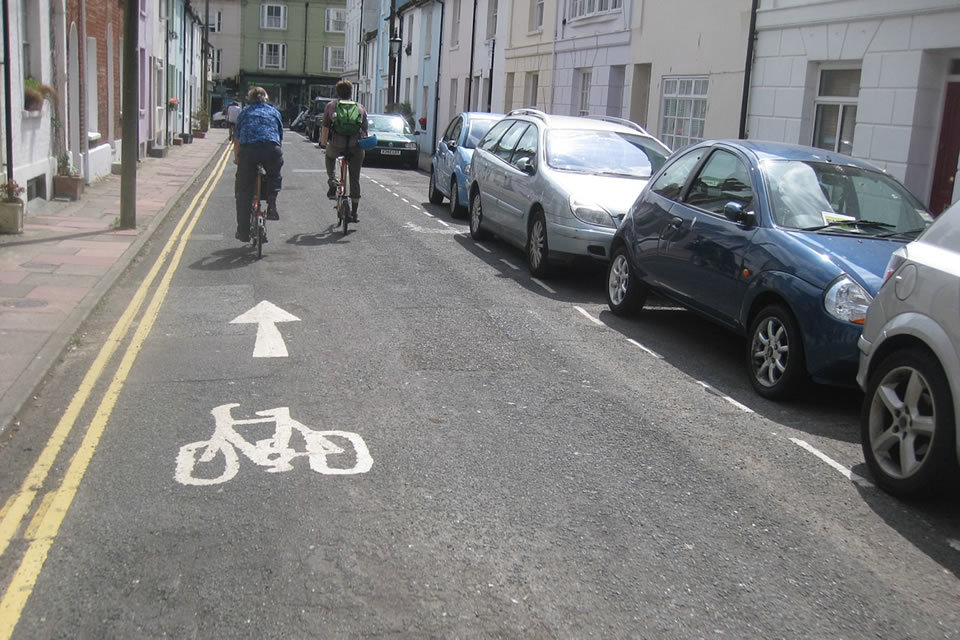Two-way cycle lanes in North Laine, Brighton
How Brighton and Hove council have introduced contraflow cycle lanes through the North Laine area on lightly used, one-way streets.

Cycling in Brighton North Laine
What we did
Brighton and Hove city council introduced contraflow cycling on a network of lightly used, narrow one-way streets. This improved access for cyclists to and through North Laine, an historic retail and residential area.
Contraflow facilities allow cyclists to travel in both directions on one-way streets. They are regarded as a good means of increasing access for cyclists where existing one-way restrictions prevent them from travelling through / within the area. They are common in many northern European and UK cities.
The scheme introduced contraflow cycling on 12 streets, which required only minor changes including some signs and road markings. Low levels of traffic and low speeds meant that cycle lane markings were not required. We chose to install repeater cycle markings along the contraflow streets to raise the visual awareness of contraflow cycling.

Brighton North Laine
The scheme cost less than £10,000, including signs, road markings, traffic orders and two new traffic signal heads at a pedestrian crossing.
Why we did it
Residents and businesses in the North Laine area had raised concerns about cyclists using footways and pedestrian alleyways. In addition, many cyclists were already choosing to ride in the contraflow direction illegally, as opposed to following the longer designated routes. The introduction of contraflow cycling through much of this area was as a means of:
- discouraging cyclists’ illegal use of footways and alleyways
- promoting greater legal cycle access to and through the area
Evidence from previous studies of contraflow cycling on quiet streets suggests that, even with no cycle lane markings, the safety of cyclists is not compromised and that different road users generally co-ordinate themselves well.
How we did it
Initially we reviewed the area’s suitability for cyclists. The first stage resulted in a map showing the existing carriageway widths and configurations, direction of operation etc. The experience of Brussels was then used, this being the only example found of a municipal authority which had developed a city-wide process to assess the feasibility of installing contraflow cycling. This process was applied to all streets in the study area as part of the assessment of whether contraflow cycling should be permitted on any particular street.

Cycling in Brighton North Laine
The second stage qualitatively assessed each street for contraflow, scoring against a set of criteria covering: visibility of cyclists, maintenance considerations, cyclist comfort (particularly at entry and exit points), role in the wider cycle network, road markings required, traffic levels and car parking.
As well as identifying streets suitable for contraflow cycling with minimal infrastructure, the report also included a number of streets which were recommended for contraflow but would require further infrastructure.
We undertook a stage 1 and 2 road safety audit before the site works, which did not raise any concerns about potential impacts on pedestrians / disabled groups. Additional repeater cycle logos were installed to increase visual awareness of contraflowing cyclists – mainly for drivers.
Consultation
Officers met with the North Laine Community Association and the North Laine Traders to introduce the permeability review and listen to the groups’ opinions on the proposed contraflow installations.
The final design did change as a result of the meetings with the residents. Officers agreed to use repeater cycle markings. Both groups put links on their websites throughout the process, informing members of progress. Officers also agreed to attend further meetings once the scheme has been in place for 6 months.
Communications
For some, the prospect of cycles ‘going the wrong way’ down one-way streets was uncomfortable, and a crucial part of the process was raising road users’ awareness of the contraflow facilities and shifting attitudes towards the idea. Officers began promoting the new facilities before the works were finished, to give as much warning as possible to all road users. This awareness raising included:
- postcards explaining what the contraflow facilities were and where cyclists would now be able to ride contraflow - the postcards were distributed to local cycling groups, Police Support Community Officers, businesses and residents
- posters displayed on lampposts in all affected streets
- two mass bike rides organised for the morning and evening peak periods to help raise awareness of cyclists using the facilities at these busiest times of the day
What we learnt
Feedback
Informal feedback on the scheme has been good. One local police community support officer involved in enforcing the scheme said:
Hardly anybody has made a fuss to me. Some people even jump off their bikes in Trafalgar Street when they see me, not realising there are contraflow lanes. I update them and give them a card with info. I’m constantly in the North Laine either foot patrol or on my bike so members of the public have plenty of opportunities to express their feelings over the cycle contraflow lanes”.
As a result of this scheme’s success further contraflow facilities are to be considered elsewhere in the city where one-way systems have a detrimental impact upon cycle access.
Area wide network
The scheme highlighted the importance of developing contraflow facilities within wider cycle networks. So a key recommendation is that, if possible, contraflow facilities should be developed as an area-wide approach.
Whilst the prospect of a contraflow network was a worrying prospect for some, it was the scheme’s biggest strength as it helped raise awareness of the concept and it increased the likelihood of cyclists using more than single individual streets.
Signs
The project identified a gap within existing contraflow guidance, which focuses mainly on addressing conflicts between vehicles and contraflow cyclists, not on potential impacts of contraflow facilities on pedestrians. There were a few streets in the North Laine where it was decided to use more signs than would normally be the case. This was because the scheme was new and visibility was an important factor. In future fewer signs should be used where road users are familiar with the concept of contraflow.
Contact and further information
For more information, email Tom Campbell on Tom.Campbell@brighton-hove.gov.uk.